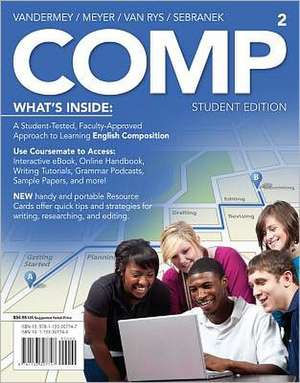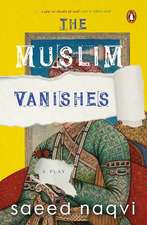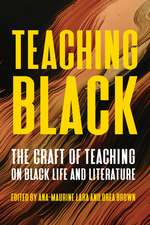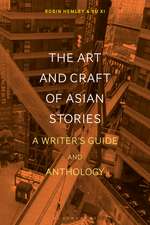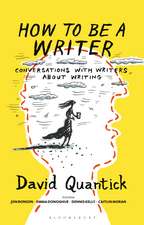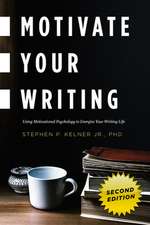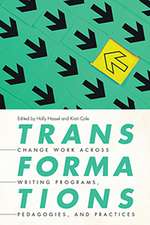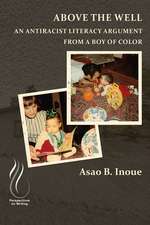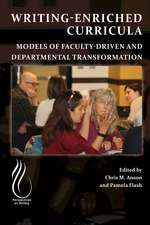COMP STUDENT/E 2/E W/CODE
en Limba Engleză Paperback – 31 dec 2011
Preț: 280.74 lei
Nou
Puncte Express: 421
Preț estimativ în valută:
53.73€ • 55.88$ • 44.35£
53.73€ • 55.88$ • 44.35£
Carte disponibilă
Livrare economică 24 martie-07 aprilie
Preluare comenzi: 021 569.72.76
Specificații
ISBN-13: 9781133307747
ISBN-10: 1133307744
Pagini: 496
Dimensiuni: 213 x 272 x 20 mm
Greutate: 1.11 kg
Ediția:Student.
Editura: Wadsworth Publishing Company
ISBN-10: 1133307744
Pagini: 496
Dimensiuni: 213 x 272 x 20 mm
Greutate: 1.11 kg
Ediția:Student.
Editura: Wadsworth Publishing Company
Recenzii
Part I: Writing Process. 1. Understanding the Reading-Writing Connection. Learning Objectives: Use the SQ3R Reading Strategy. Read actively. Summarize a text. View and interpret images thoughtfully. Think critically through writing. 2. One Writer's Process. Learning Objectives: Initiate the process. Plan the writing. Write the first draft. Complete a first revision. Complete a second revision. Edit the writing for style. Edit the writing for correctness. Complete the final copy. Student Model: "Clean Water is Everyone's Business" by Angela Franco. 3. Starting. Learning Objectives: Discover your process. Recognize seven traits of effective writing. Analyze the situation. Understand the assignment. Select a topic. Gather details. 4. Planning. Learning Objectives: Take inventory of your thoughts. Form your thesis statement. Select a method of development. Develop a plan or an outline. 5. Drafting. Learning Objectives: Review the writing situation. Open with interest. Develop the middle. End with purpose. Use sources effectively. Student Models: "Seeing the Light" by David Zupp. "The Production of Cement" by Kevin Mass. "Hypothermia" by Laura Black. "Four Temperaments" by Jessica Radsma. "My Obsession" by Paula Treick. "Entering the Green Room" by Luke Sunukjian. Professional Models: "Mall Security Immunity" by Rob King. "Writers Rule" by Lester Smith. "Grotesque" by John Van Rys. "Of Human Bondage" by W. Somerset Maugham. 6. Revising. Learning Objectives: Address whole-paper issues. Revise your first draft. Revise for ideas and organization. Revise for voice. Address paragraph issues. Revise collaboratively. Use the writing center. 7. Editing. Learning Objectives: Review the overall style of your writing. Write effective sentences. Check your sentences for style and correctness. Replace imprecise, misleading, and biased words. Edit and proofread for conventions. 8. Publishing. Learning Objectives: Format your writing. Create a writing portfolio. Part II: Forms of Writing. 9. Narration, Description, and Reflection. Anecdote Models: Anecdote introducing a topic (from "Deft or Daft"). Anecdote illustrating a point (from "Shades of Prejudice"). Student Models: "The Entomology of Village Life" by Robert Minto. "Spare Change" by Teresa Zsuffa. Professional Models: "When Dreams Take Flight" by Elizabeth Fuller. "The Muscle Mystique" by Barbara Kingsolver. Guidelines. Analytical Writing. 10. Definition. Student Models: "Economic Disparities Fuel Human Trafficking" by Shon Bogar. "The Gullible Family" by Mary Beth Bruins. Professional Models: "Deft or Daft" by David Schelhaas. "Wikipedia and the Meaning of Truth" by Simson L. Garfinkle. Guidelines. 11. Classification. Student Model: "Latin American Music: A Diverse and Unifying Force" by Kathleen Kropp. Professional Models: "Four Sides to Every Story" by Steward Brand. "Four Ways to talk About Literature" by John Van Rys. Guidelines. 12. Process. Student Model: "Wayward Cells" by Kerri Mertz. Professional Models: "Love and Race" by Nicholas D. Kristof. "The End of Race as We Know It" by Gerald L. Early. "Instructions" by Verne Meyer. Guidelines. 13. Comparison-Contrast. Student Model: "Sethe in Beloved and Orleanna in Poisonwood Bible: Isolation, Children, and Getting Out" by Rachel De Smith. Professional Models: "Shrouded in Contradiction" by Gelareh Asayesh. "Shades of Prejudice" by Shankar Vedantam. Guidelines. 14. Cause-Effect. Student Models: "Adrenaline Junkies" by Sarah Hanley. "Dutch Discord" by Brittany Korver. Professional Models: "If You Let Me Play ... " by Mary Brophy Marcus. "Mind Over Mass Media" by Steven Pinker. Guidelines. Persuasive Writing. 15. Strategies for Argumentation & Persuasion. Learning Objectives: Understand an argument. Recognize an argument's organization. Understand what makes a strong claim. Identify claims of truth, value, and policy. Assess the quality of the support. Recognize logical fallacies. Learn about additional strategies. Professional Model: "Uncle Sam and Aunt Samantha" Anna Quindlen. 16. Taking a Position. Student Models: "Ah, the Power of Women" by Aleah Stenberg. "Nuclear Is Not the Answer" by Alyssa Woudstra. Professional Models: "Animal, Vegetable, Miserable" by Gary Steiner. "Sorry, Vegans: Brussels Sprouts Like to Live, Too" by Natalie Angier. Guidelines. 17. Persuading Readers to Act. Student Models: "To Drill or Not To Drill" by Rebecca Pasok. "Our Wealth: Where Is It Taking Us?" by Henry Veldboom. Professional Models: "I Have a Dream" by Martin Luther King. "In Africa, AIDS Has a Woman's Face" by Kofi A. Annan. Guidelines. 18. Proposing a Solution. Student Models: "Dream Act May Help Local Student Fight for Residence" by Renee Wielenga. "Preparing for AgroTerror" by Brian Ley. Professional Models: "Fatherless America" by David Blankenhorn. "Is It Now a Crime to Be Poor?" by Barbara Ehrenreich. Guidelines. Report Writing. 19. Interview Report. Student Model: "The Dead Business" Benjamin Meyer. Professional Model: "Arcade Fire, on fame and putting it to good use" by Jonathon Gatehouse. Guidelines. 20. Lab, Experiment, and Field Reports. Student Models: Lab: "Working with Hydrochloric Acid" by Coby Williams. Experiment: "The Effects of Temperature and Inhibitors on the Fermentation Process for Ethanol" by Andrea Pizano. Professional Model: Field: "Investigation of Cockroach Infestation at 5690 Cherryhill" by Hue Nguyen. Guidelines. Special Forms of Writing. 21. Analyzing the Arts. Guidelines: Fiction, Poetry, and Film. Student Models: Fiction: "'Good Country People': Broken Body, Broken Soul" by Anya Terekhina. Poem: "'Let Evening Come': An Invitation to the Inevitable" by Sherry Van Egdom. Film: "Terror on the Silver Screen: Who Are the Aliens?" by David Schaap. 22. Workplace Writing. Learning Objective: Create correspondence. Models: E-Mail. Memo. Learning Objective: Correctly format a letter. Models: Letter of Invitation. Letter of Application. Recommendation Request. Learning Objective: Write an Application Essay. Model: Personal Statement. Learning Objective: Prepare a Resume. Models: Print Resume. Digital Resume. 23. Web Writing. Learning Objectives: Understand page elements. Develop a Web site. Consider sample sites. Understand other writing venues. Develop a blog. Contribute to a wiki. Models: The Museum of Flight home page. Southwest Sojourners home page. Academic: Space Nanotechnology Laboratory home page. Sample blog and sample wiki pages. 24. Assessment. Learning Objectives: Prepare for exams. Respond to essay questions. Understand objective questions. Research Writing. 25. Planning Your Research Project. Learning Objectives: Understand academic research. Initiate the process. Develop a research plan. Consider possible resources and sites. Understand sources. 26. Doing Your Research. Learning Objectives: Learn keyword searching. Conduct primary research. Do library research. Use books. Find periodical articles. Understand the Internet. Find reliable free-web information. 27. Working with Your Sources. Learning Objectives: Evaluate your sources. Create a working bibliography. Review note taking. Summarize, paraphrase, and quote. 28. Writing a Research Paper. Learning Objectives: Avoid plagiarism. Avoid other source abuses. Use sources well. Write your research paper. Follow a model. Professional Models: "Some Stories Have to Be Told by Me: A Literary History of Alice Munro" (Excerpt) by Marcela Valdes. "Vehicle of Change" (Excerpt) L.D. Burns, J.B. McCormick, C.E. Borroni-Bird. Student Model: "'I Did Not Get My Spaghetti-O's': Death Row Consumption in the Popular Media" by Stevie Jeung. 29. MLA and APA Styles. Learning Objectives: Learn the basics of MLA & APA style. Understand in-text citations. List books and other nonperiodical documents. List print periodical articles. List online sources. List other sources: primary, personal, and multimedia. Update documentation strategies above as needed. MLA Model: "'I Did Not Get My Spaghetti-O's': Death Row Consumption in the Popular Media" (see chapter 28). APA Model: "Dutch Discord" (see chapter 14). Part III: Handbook. 30. Grammar. Noun. Pronoun. Verb. Adjective. Adverb. Preposition. Conjunction. Interjection. 31. Sentences. Subjects and Predicates. Phrases. Clauses. Sentence Variety. 32. Sentence Errors. Subject-Verb Agreement. Pronoun-Antecedent Agreement. Shifts in Sentence Construction. Fragments. Comma Splices. Run-Ons. Misplaced and Dangling Modifiers. Ambiguous Wording. Nonstandard Language. 33. Punctuation. Period. Ellipsis. Comma. Semicolon. Colon. Hyphen. Dash. Question Mark. Quotation Marks. Italics (Underlining). Parentheses. Diagonal. Brackets. Exclamation Point. Apostrophe. 34. Mechanics. Capitalization. Plurals. Numbers. Abbreviations. Acronyms and Initialisms. Basic Spelling Rules. 35. Multilingual and ESL Guidelines. Parts of Speech. Sentence Basics. Sentence Problems. Numbers. Word Parts. Idioms.
